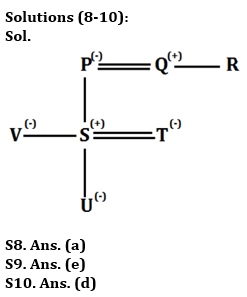Directions (1-5): In these questions, relationship between different elements is shown in the statements. These statements are followed by two conclusions:
(a) if only conclusion I follows.
(b) if only conclusion II follows.
(c) if either conclusion I or II follows.
(d) if neither conclusion I nor II follows.
(e) if both conclusion I and II follow.
Q1. Statements: N=P, P≤F, F≥L, L=K
Conclusions: I. F=K
II. F>K
Q2. Statements: Z>T<M<J
Conclusions: I. T<J
II. J<Z
Q3. Statements: Q=Z, C≥G, G≥Q, Q≥R, J≥C
Conclusions: I. G≥Z
II. C≥R
Q4. Statements: A>B>C<D>E>F
Conclusions: I. E>C
II. F>B
Q5. Statements: K<L, K>M, M≥N, N>O
Conclusions: I. O<M
II. O<K
Directions (6-7): Study the information carefully and answer the questions given below.
P is father of M who is brother-in-law of K. N is daughter in law of Z who is grandmother of L. P has only two children one son and one daughter. X is sister-in-law of N. P is father-in-law of N. K is unmarried.
Q6. If K is wife of J, then what could be the relation of J with respect to N?
(a) Brother
(b) Brother-in-law
(c) Uncle
(d) Cannot be determined
(e) None of these.
Q7. What is relation of L with respect to X?
(a) Nephew
(b) Niece
(c) Son
(d) Daughter
(e) Cannot be determined
Directions (8-10): Study the following information carefully to answer the questions given below:
P, Q, R, S, U, V and T are the members of a family. There are three generation in this family. P is mother-in-law of T. V is sister of S who is nephew of R. U is granddaughter of Q. T is a married woman. R is not sibling of P.
Q8. Who among the following is niece of V?
(a) U
(b) Q
(c) R
(d) T
(e) None of these
Q9. How is R related to V?
(a) Niece
(b) Father
(c) Aunt
(d) Uncle
(e) Cannot be determine
Q10. Who among the following is mother of U?
(a) V
(b) R
(c) P
(d) T
(e) None of these
Solutions
Solutions (1-5):
S1. Ans. (c)
Sol. I. F=K(FALSE)
II. F>K(FALSE)
S2. Ans. (a)
Sol. I. T<J(TRUE)
II. J<Z(FALSE)
S3. Ans. (e)
Sol. I. G≥Z (TRUE)
II. C≥R (TRUE)
S4. Ans. (d)
Sol. I. E>C(FALSE)
II. F>B(FALSE)
S5. Ans. (e)
Sol. I. O<M(TRUE)
II. O<K(TRUE)







 GA Capsule for SBI Clerk Mains 2025, Dow...
GA Capsule for SBI Clerk Mains 2025, Dow...
 The Hindu Review October 2022: Download ...
The Hindu Review October 2022: Download ...
 ECGC PO Cut off 2025 Out, Check Final Cu...
ECGC PO Cut off 2025 Out, Check Final Cu...




